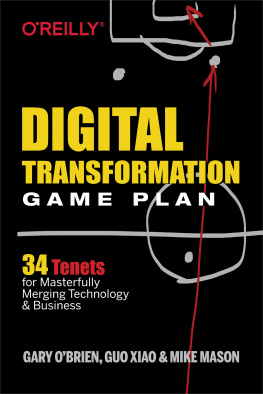Geng Lin - Enterprise Architecture for Digital Business: Transforming IT
Here you can read online Geng Lin - Enterprise Architecture for Digital Business: Transforming IT full text of the book (entire story) in english for free. Download pdf and epub, get meaning, cover and reviews about this ebook. year: 2022, publisher: OReilly Media, genre: Business. Description of the work, (preface) as well as reviews are available. Best literature library LitArk.com created for fans of good reading and offers a wide selection of genres:
Romance novel
Science fiction
Adventure
Detective
Science
History
Home and family
Prose
Art
Politics
Computer
Non-fiction
Religion
Business
Children
Humor
Choose a favorite category and find really read worthwhile books. Enjoy immersion in the world of imagination, feel the emotions of the characters or learn something new for yourself, make an fascinating discovery.
- Book:Enterprise Architecture for Digital Business: Transforming IT
- Author:
- Publisher:OReilly Media
- Genre:
- Year:2022
- Rating:4 / 5
- Favourites:Add to favourites
- Your mark:
Enterprise Architecture for Digital Business: Transforming IT: summary, description and annotation
We offer to read an annotation, description, summary or preface (depends on what the author of the book "Enterprise Architecture for Digital Business: Transforming IT" wrote himself). If you haven't found the necessary information about the book — write in the comments, we will try to find it.
Digital transformation has accelerated nearly tenfold in recent years as both a business and technology journey. Yet, most white papers and how-to guides still focus solely on the business side, rather than include methods for optimizing the technology behind it. This handbook shows CIOs, IT directors, and architects how to balance these two concerns successfully.
Youll explore current technology trends and shifts required to build a digital business, including how enterprise architecture should evolve if its to sustain and grow your business. A CIO who can handle digital transformation along with business interests is a rare find. This is the ideal guide to modernizing IT.
Youll examine:
- The latest trends and technologies driving the need for a digital enterprise architecture
- New components, layers, and concepts that comprise a framework for digital enterprise architecture
- Skills and technologies you need to modernize an enterprise architecture for a digital business
- Domains and characteristics of a digital enterprise architecture
- How to map digital enterprise technologies to the appropriate teams
Geng Lin: author's other books
Who wrote Enterprise Architecture for Digital Business: Transforming IT? Find out the surname, the name of the author of the book and a list of all author's works by series.










